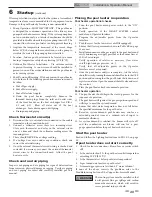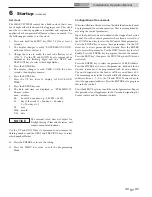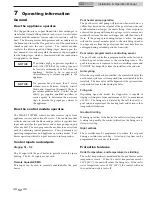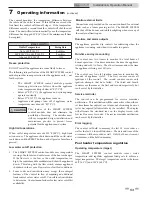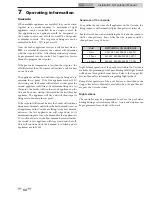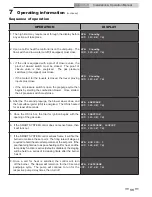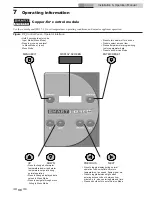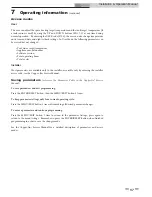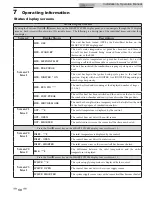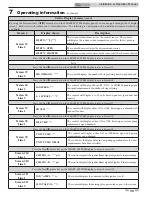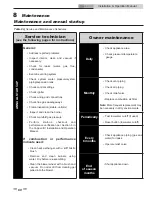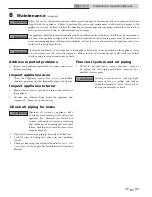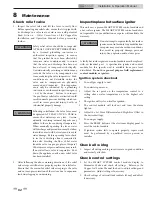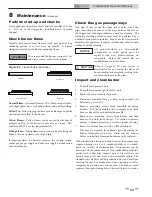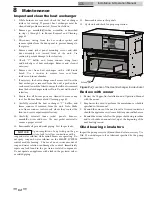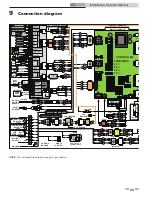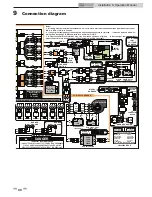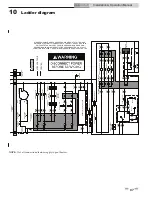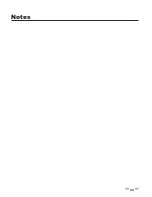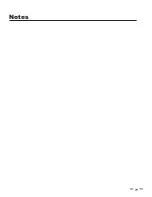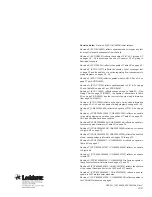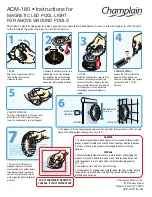
Installation & Operation Manual
8
Maintenance
(continued)
63
Check burner flame
Visually check main burner flames at each start-up after long
shutdown periods or at least every six months. A burner
viewport is located on the burner mounting flange.
Perform start-up and checks
Start appliance and perform checks and tests specified in
Section
6 - Start-up
of the Copper-fin
2
Installation and Operation
Manual.
The area around the burner viewport is hot
and direct contact could result in burns.
⚠
WARNING
Figure 8-1_
Flame Pattern Illustration
Normal Flame:
A normal flame at 100% of burner input is blue,
with slight yellow tips, a well defined flame and no flame lifting.
Yellow Tip:
Yellow tipping can be caused by blockage or partial
obstruction of air flow to the burner.
Yellow Flames:
Yellow flames can be caused by blockage of
primary air flow to the burner or excessive gas input. This
condition MUST be corrected immediately.
Lifting Flames:
Lifting flames can be caused by over firing the
burner, excessive primary air or high draft.
If improper flame is observed, examine the venting system,
ensure proper gas supply and adequate supply of combustion
and ventilation air.
Check flue gas passageways
Any sign of soot around the inner jacket, outer jacket, flue
pipe connections, burner or in the areas between the fins on
the copper heat exchanger indicates a need for cleaning. The
following cleaning procedure must only be performed by a
qualified serviceman or installer. Proper service is required to
maintain safe operation. Properly installed and adjusted units
seldom need flue cleaning.
All gaskets/sealants on disassembled
components or jacket panels must be
replaced with new gaskets/sealants on
reassembly. Gasket and sealant kits are
available from your distributor.
NOTICE
⚠
CAUTION
When a Category IV vent system is
disconnected for any reason, the flue must
be reassembled and resealed according to the
vent manufacturer’s instructions.
Inspect and clean burner
1. Turn off main power to unit.
2. Turn off main manual gas shutoff to unit.
3. Remove the front outer jacket panels.
4. Disconnect manifold from gas train using union(s) just
below each gas valve(s).
5. Remove mounting screws from manifold mounting
brackets. Pull the manifold/orifice assembly away from
burners. Repeat for each manifold assembly.
6. Remove two mounting screws from burner and slide
burner out toward front of unit. Use caution to prevent
damage to burners, refractory, hot surface igniter or wiring.
7. Remove soot from burners with a stiff bristle brush.
Dirt may be removed from burner ports by rinsing the
burner thoroughly with water. Drain and dry burners
before re-installing. Damaged burners must be replaced.
NORMAL
YELLOW FLAME
FLAME LIFT
YELLOW TIP
When installed in a dusty and dirty location, the burners may
require cleaning on a 3 to 6 month schedule or as needed,
based on severity of contamination. Contaminants can be
drawn in with the combustion air. Non combustible particulate
matter such as dust, dirt, concrete dust or dry wall dust can
block burner ports and cause non-warrantable failure. The
standard inlet air filter will help eliminate dust and dirt from
entering the unit. Use extreme care when operating a unit for
temporary heat during new construction. The burners could
require a thorough cleaning before the unit is placed in service.

